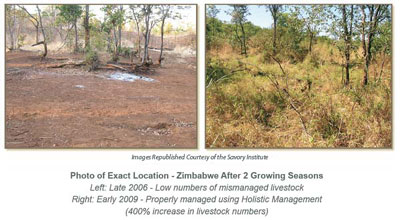These days cows have gotten bad press because of the methane they belch and the huge amounts of water and food it takes to sustain them, in factory farms that is.
But cows can play a crucial positive role if they are out on the range.
We’ve followed Allan Savory’s work for decades as he’s battled a key misconception: cattle grazing doesn’t cause desertification – in fact, we must dramatically increase their numbers in order to reverse it.
In 2010, Savory won the Buckminster Fuller Challenge for his Zimbabwe Grasslands Project, Operation Hope.
His strategy has transformed parched, degraded Zimbabwe grasslands and savannahs into lush pastures with ponds and flowing streams, even during periods of drought.
Savory’s successful approach to land management contradicts accepted practice, which says land must rest from animal grazing. When animals are removed, he’s found the land becomes more degraded, not less.
His process re-establishes the symbiotic balance between plant growth and the behavior of herding animals, returning unusable desert back into thriving grasslands – restoring biodiversity, bringing water sources back to life, combating global climate change, and increasing crop yields to ensure food security for people. The approach is currently producing results on over 30 million acres worldwide.

Only healthy soil sequesters carbon. Damaged soil leads to desertification and the release of greenhouse gas emissions. A staggering two-thirds of earth’s land mass is desertifying, he says.
This is easily seen with satellite images.
"By some estimates, grazing large herds of livestock on half the world’s barren or semi-barren grasslands could take enough carbon from the atmosphere to bring us back to preindustrial levels. Nothing offers more hope," says Savory.
Even grasslands that get plenty of rain are desertifying. "If you inspect the ground in tall grasslands, it is bare and encrusted with algae, which leads to runoff and evaporation."
Areas of US national parks are now desertifying as badly as areas in Africa, and studies have shown that whenever cattle are removed from an area to protect it from desertification, the opposite results – it gets worse.
Not only have we failed to understand the causes of desertification, we’ve failed to understand how it affects our global climate, says Savory. He explains that barren earth is much cooler at dawn and much hotter at midday. When land is left barren, it changes the microclimate on that swath of land.
"Once you’ve done that to more than half of the land mass on planet, you’re changing macroclimate," he says.
He continues:
We’ve failed to realize that in seasonal humidity environments, the soil and vegetation developed with very large numbers of grazing animals meandering through. Along with these herds came ferocious pack hunting predators. The primary defense against these predators was the herd size. The larger the herd, the safer the individual animal within the herd. These large herds deposited dung and urine all over the grasses (their food), and so they would keep moving from one area to the next.
This constant movement of large herds naturally prevented overgrazing of plants, while periodic trampling ensured protective covering of the soil. Grasses must degrade biologically before the next growing season, which easily occurs if it is trampled into the ground. But if it doesn’t decay biologically, it shifts into oxidation – a very slow process that results in bare soil, which then ends up releasing carbon. To prevent this scenario, we’ve traditionally used fire. But burning the ground also leaves soil bare to release carbon.
Rather than converting our native grasslands to GMO corn and soy, and keeping cattle confined in feedlots, US policy should encourage farmers to graze cows.
What we need is a smaller-scale system created by independent producers and processors focused on local and regional markets. Following Savory’s strategy, large herds could be moved across areas in planned grazing patterns, which would be beneficial for the environment, the health of the animals, and subsequently the health of humans consuming those animals.
Grasslands, LLC
Alan Savory’s group, The Savory Institute, has created Grasslands LLC to commercialize his concepts. The company will find attractive ranch real estate investments, raise capital to purchase them and then restore the land via long-term management contracts.
Read the full article and watch his excellent video at Mercola:

Alan Savory’s work is amazing.
Blindingly obvious once he points it out.
Maybe we CAN have our steak and eat it too?